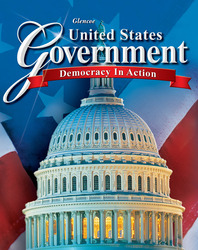United States Government: Democracy in ActionUnit 7:
Public Policies and ServicesBig Idea Activity — Lesson Plan <a onClick="window.open('/olcweb/cgi/pluginpop.cgi?it=jpg::::/sites/dl/free/0078799821/680642/big_idea.jpg','popWin', 'width=NaN,height=NaN,resizable,scrollbars');" href="#"><img valign="absmiddle" height="16" width="16" border="0" src="/olcweb/styles/shared/linkicons/image.gif"> (10.0K)</a> <a onClick="window.open('/olcweb/cgi/pluginpop.cgi?it=jpg::::/sites/dl/free/0078799821/680642/big_idea.jpg','popWin', 'width=NaN,height=NaN,resizable,scrollbars');" href="#"><img valign="absmiddle" height="16" width="16" border="0" src="/olcweb/styles/shared/linkicons/image.gif"> (10.0K)</a>
Are U.S. tax dollars being spent wisely?
Assignment: Investigate Government Spending
Students will investigate a GAO report and prepare a "televised" newscast summarizing their research. Assignment Task List
Step 1: Students will review the sources of government revenues, and major spending categories. They are asked to complete two circle graphs with percentages discussed in the textbook.  <a onClick="window.open('/olcweb/cgi/pluginpop.cgi?it=jpg::::/sites/dl/free/0078799821/680643/iwb_logo.jpg','popWin', 'width=NaN,height=NaN,resizable,scrollbars');" href="#"><img valign="absmiddle" height="16" width="16" border="0" src="/olcweb/styles/shared/linkicons/image.gif"> (8.0K)</a> Project the circle graphs from
StudentWorks Plus Online, page 557 of the Student Edition onto the whiteboard. Ask students to identify the three largest sources of federal revenue. (individual income tax, social insurance taxes and retirement receipts, corporate income tax) What are the three largest federal expenditures? (Medicare, health, and income security; Social Security; and national defense) <a onClick="window.open('/olcweb/cgi/pluginpop.cgi?it=jpg::::/sites/dl/free/0078799821/680643/iwb_logo.jpg','popWin', 'width=NaN,height=NaN,resizable,scrollbars');" href="#"><img valign="absmiddle" height="16" width="16" border="0" src="/olcweb/styles/shared/linkicons/image.gif"> (8.0K)</a> Project the circle graphs from
StudentWorks Plus Online, page 557 of the Student Edition onto the whiteboard. Ask students to identify the three largest sources of federal revenue. (individual income tax, social insurance taxes and retirement receipts, corporate income tax) What are the three largest federal expenditures? (Medicare, health, and income security; Social Security; and national defense)
Step 2: Students will sequence the federal budget process. They will write each step in the correct order on a chart like the one below. Steps in Preparing and Passing the Federal Budget | Step 1: | Federal agencies submit their spending plans to the OMB, which takes them to the president. | Step 2: | The president, the secretary of the treasury, and the Council of Economic Advisers meet to discuss the budget. | Step 3: | The president sends guidelines to the agencies, which review their budgets and change them according to the president's guidelines. | Step 4: | The OMB sends the president a completed budget for review and approval; the president may then make changes to the budget before it is final. | Step 5: | The president's budget goes to Congress; House and Senate Budget Committees review it, prepare a concurrent resolution, and begin the reconciliation process. | Step 6: | The OMB and CBO issue a joint report, cut the budget to comply with the Gramm-Rudman-Hollings Act, meet deficit-reduction targets, and approve the final budget. |
 <a onClick="window.open('/olcweb/cgi/pluginpop.cgi?it=jpg::::/sites/dl/free/0078799821/680642/BL.jpg','popWin', 'width=NaN,height=NaN,resizable,scrollbars');" href="#"><img valign="absmiddle" height="16" width="16" border="0" src="/olcweb/styles/shared/linkicons/image.gif"> (0.0K)</a> Differentiated Instruction <a onClick="window.open('/olcweb/cgi/pluginpop.cgi?it=jpg::::/sites/dl/free/0078799821/680642/BL.jpg','popWin', 'width=NaN,height=NaN,resizable,scrollbars');" href="#"><img valign="absmiddle" height="16" width="16" border="0" src="/olcweb/styles/shared/linkicons/image.gif"> (0.0K)</a> Differentiated Instruction <a onClick="window.open('/olcweb/cgi/pluginpop.cgi?it=jpg::::/sites/dl/free/0078799821/680643/iwb_logo.jpg','popWin', 'width=NaN,height=NaN,resizable,scrollbars');" href="#"><img valign="absmiddle" height="16" width="16" border="0" src="/olcweb/styles/shared/linkicons/image.gif"> (8.0K)</a> Project the flow chart from <a onClick="window.open('/olcweb/cgi/pluginpop.cgi?it=jpg::::/sites/dl/free/0078799821/680643/iwb_logo.jpg','popWin', 'width=NaN,height=NaN,resizable,scrollbars');" href="#"><img valign="absmiddle" height="16" width="16" border="0" src="/olcweb/styles/shared/linkicons/image.gif"> (8.0K)</a> Project the flow chart from  page 60
(64.0K)
in the Chapter Summaries onto the whiteboard. Ask a volunteer to come to the board and write each step in the correct order on the flow chart. page 60
(64.0K)
in the Chapter Summaries onto the whiteboard. Ask a volunteer to come to the board and write each step in the correct order on the flow chart.
|
Step 3: Students will gather online information about one aspect of government spending. Send them to the Government Accountability Office (GAO) Web site at www.gao.gov. Have them click on the tab "Topic Collections" near the top of the screen, select a topic, and then click on one of the issues related to that topic. Students should identify the issue's title, date, and government department or agency overseeing the spending. Step 4: Students should read and summarizethe issue, and then prepare the information as a five-minute broadcast story for the evening news. Prompt them to prepare visual aids (graphs, charts, photographs) to supplement and help explain the news story. They must conclude their broadcasts by adding a "public service opinion" about whether the issue was an example of wise government spending or wasteful government spending.  <a onClick="window.open('/olcweb/cgi/pluginpop.cgi?it=jpg::::/sites/dl/free/0078799821/680642/BL.jpg','popWin', 'width=NaN,height=NaN,resizable,scrollbars');" href="#"><img valign="absmiddle" height="16" width="16" border="0" src="/olcweb/styles/shared/linkicons/image.gif"> (0.0K)</a> Differentiated Instruction <a onClick="window.open('/olcweb/cgi/pluginpop.cgi?it=jpg::::/sites/dl/free/0078799821/680642/BL.jpg','popWin', 'width=NaN,height=NaN,resizable,scrollbars');" href="#"><img valign="absmiddle" height="16" width="16" border="0" src="/olcweb/styles/shared/linkicons/image.gif"> (0.0K)</a> Differentiated Instruction <a onClick="window.open('/olcweb/cgi/pluginpop.cgi?it=jpg::::/sites/dl/free/0078799821/680643/iwb_logo.jpg','popWin', 'width=NaN,height=NaN,resizable,scrollbars');" href="#"><img valign="absmiddle" height="16" width="16" border="0" src="/olcweb/styles/shared/linkicons/image.gif"> (8.0K)</a> Project the <a onClick="window.open('/olcweb/cgi/pluginpop.cgi?it=jpg::::/sites/dl/free/0078799821/680643/iwb_logo.jpg','popWin', 'width=NaN,height=NaN,resizable,scrollbars');" href="#"><img valign="absmiddle" height="16" width="16" border="0" src="/olcweb/styles/shared/linkicons/image.gif"> (8.0K)</a> Project the  Writing Process Transparency 7: Map Out a Plan
(37.0K)
. Demonstrate how to outline a script in the "Map Out a Plan" chart. Writing Process Transparency 7: Map Out a Plan
(37.0K)
. Demonstrate how to outline a script in the "Map Out a Plan" chart.
|
Step 5: Have students present their "broadcasts" to the rest of the class. Ask them to peer assess one another's broadcasts using the following rubric:
___ Who? What? Where? When? Why? and How? questions answered
___ detailed research that shows a deep understanding of the subject
___ eloquent and creative presentation
___ speaker communicates well with the audience
___ clear and smooth transitions in presentation
___ at least two visual aids used effectively  <a onClick="window.open('/olcweb/cgi/pluginpop.cgi?it=jpg::::/sites/dl/free/0078799821/680642/big_idea.jpg','popWin', 'width=NaN,height=NaN,resizable,scrollbars');" href="#"><img valign="absmiddle" height="16" width="16" border="0" src="/olcweb/styles/shared/linkicons/image.gif"> (10.0K)</a> <a onClick="window.open('/olcweb/cgi/pluginpop.cgi?it=jpg::::/sites/dl/free/0078799821/680642/big_idea.jpg','popWin', 'width=NaN,height=NaN,resizable,scrollbars');" href="#"><img valign="absmiddle" height="16" width="16" border="0" src="/olcweb/styles/shared/linkicons/image.gif"> (10.0K)</a>
After all of the broadcasts have been presented, have students discuss this question: Are U.S. tax dollars being spent wisely?
 |  |




















